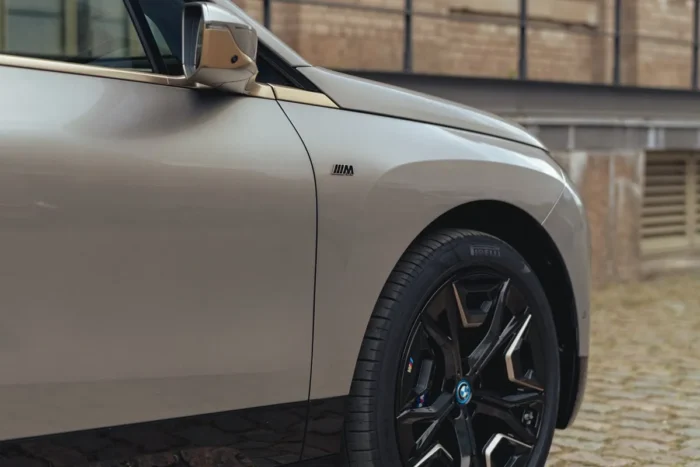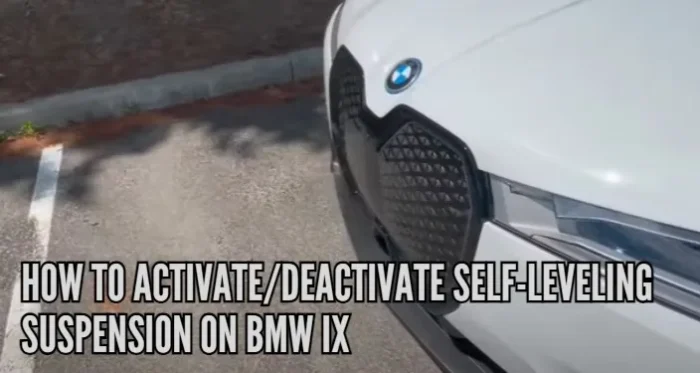How to activate/deactivate self-leveling suspension on BMW iX
We're an affiliate
We hope you love the products we recommend! Just so you know, we may collect a share of sales or other compensation from the links on this page. Thank you if you use our links, we really appreciate it!
Table of Contents

In the 1950s, when Citroen introduced the first self-leveling suspension, car manufacturers were scrambling to develop their own designs. Looking for their own individual way to ensure that their vehicle can maintain the same level, no matter the load.
Since then, cars of all shapes and sizes have featured self-leveling suspension, both from the factory and as optional extras. These have been used for both comfort and convenience purposes. The new BMW iX is one of the latest vehicles to add this feature to its repertoire.

If you own a BMW iX and want to find out how to activate or deactivate this feature, keep reading.
Table of Contents
How does BMW iX air suspension work?

Self-leveling suspension works by adjusting the vehicle’s ride height based on the weight distribution. For example, the car will automatically raise its rear end if the trunk has an especially heavy load. Thus, it accounts for the extra weight over the rear axle.
The BMW iX air suspension uses this method to ensure a consistent ride height. The vehicle’s level is kept constant regardless of the weight of the load.
However, depending on the driving circumstances, the level can be adjusted to different positions, such as:
- Normal level, which is ideal for typical road conditions
- Elevated level, which is suitable for driving in poor conditions or light terrain at a reduced speed
Activating and deactivating BMW iX self-leveling suspension

If you find yourself in a scenario where the self-leveling suspension is not necessary, you may want to deactivate the system temporarily. The self-leveling button to change the BMW iX suspension is located in the vehicle’s center.
It’s an icon of a car with an up arrow inside.
To deactivate the self-leveling suspension system, follow these instructions:
- Press and hold the button for approximately 7 seconds.
- The LED flashes rapidly.
To activate the system, do precisely the same thing:
- Press and hold the button for approximately 7 seconds.
- Release it.
The button itself displays the current state of the self-leveling suspension. The system has four states:
- LED off: the IX is at its normal level
- The LED flashes: vehicle level is being adjusted
- LED is illuminated: the vehicle is at a raised level
- The LED flashes rapidly: vehicle level adjustment is not available
How different driving modes affect the BMW iX suspension
The BMW iX air suspension system offers various shock absorber settings that range from comfortable travel to sporty driving. These settings are assigned to different drive modes.
Pressing the button in the vehicle adjusts the vehicle level manually. In the low-speed range, the IX raises to an elevated level when the button is activated. The car automatically lowers in ‘Sport Mode’ or at higher speeds.
If the vehicle adjusts the suspension level per your speed, the selected drive mode will define the new level.
System limits and safety considerations

In certain situations, changing the BMW iX suspension level may not be available. Below is a not exhaustive list of scenarios this may occur:
- During sporty driving
- When the axles are articulating
- If the vehicle battery is not sufficiently charged
- One or more of the vehicle’s doors are open
- If the payload is increased, the system may disable the highest driving level or exit it automatically
- If the system overheats due to several level changes in quick succession, it may temporarily become unavailable, and system operation may be delayed
In case of a malfunction, the BMW iX air suspension system will have noticeably different handling characteristics or restricted driving comfort.
When this occurs, it’s essential to have the system checked by a Service Partner or a specialist workshop.
Conclusion
In conclusion, while self-leveling suspension has existed since Citroen introduced it in the 1950s, the BMW iX air suspension system is an excellent addition to the vehicle, providing exceptional driving comfort regardless of the load conditions.
However, it is essential to keep in mind the system’s limits, safety considerations, and how to handle malfunctions if they occur. With proper use and care, the BMW iX air suspension system will continue to enhance the driving experience for many years.
As always, please ensure you drive with due care and attention. If you have any issues or queries, consult the owner’s manual below or a qualified Service Partner.

FAQs
What is self-leveling suspension, and why is it important in a vehicle like the BMW iX?
Self-leveling suspension automatically adjusts the vehicle’s ride height based on weight distribution. It’s crucial for vehicles like the BMW iX to maintain a consistent ride height, ensuring comfort and stability regardless of the load.
How do I activate or deactivate the self-leveling suspension in my BMW iX?
To activate or deactivate the system, press and hold the button with the up arrow icon for approximately 7 seconds. The LED indicator will help you know the current status.
What are the different ride heights offered by the BMW iX air suspension?
The BMW iX air suspension offers two main ride heights: the “Normal level” for typical road conditions and the “Elevated level” for poor conditions or light terrain at lower speeds.
How do different driving modes affect the BMW iX suspension?
The suspension system has various shock absorber settings assigned to different driving modes. When you adjust the vehicle level manually or use a specific drive mode, the suspension adapts accordingly.
Are there any safety considerations or system limits I should be aware of when using the self-leveling suspension in the BMW iX?
Yes, there are system limits. It may not be possible to change the suspension level in certain situations, such as during sporty driving, when the axles are articulating, if the vehicle battery is low, or when doors are open. Additionally, overheating due to rapid level changes can temporarily disable the system.
Categorised in: Advice, Automotive, How-tos





